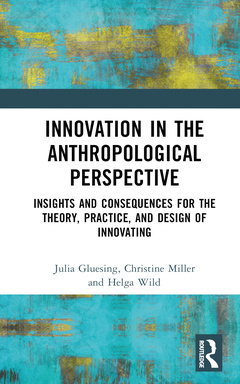Innovation in the Anthropological Perspective Insights and Consequences for the Theory, Practice, and Design of Innovating
Auteurs : Gluesing Julia C., Miller Christine, Wild Helga

Innovation is a constant in human life and organization, arising from within a context-based culture of social structures and beliefs. This book re-examines the processes, practices, and mechanisms of innovation from an anthropological perspective, offering a theory of innovation as a dynamic multidimensional system. It uses methods and stories across a broad arc of time, place, social and cultural context, and subject matter. The chapters explore the intersection of virtual, local, and global dynamics and deepen our understanding of aspects and dimensions of innovation that challenge common perceptions, particularly in business and organizational environments. The approach aims to situate innovation in an integrated view of human and non-human ecologies, and to create common ground for a new form of research and practice.
Tables & figures
Foreword
1 Introduction
1.1 A meeting of minds
1.2 Who we are
1.3 Why we wrote this book
1.4 Who the book is for
1.5 How the book is organized
1.6 How this book can be used to advantage
2 Innovation lenses
2.1 Innovation lenses
2.2 Lens 1: Innovation, discovery and invention
2.3 Lens 2: Innovation, stability and disruption
2.4 Lens 3: Innovation, creation and transmission
2.5 Lens 4: Innovation and design
3 Anthropological perspective
3.1 Concept of culture
3.2 Culture as a system of H.E.L.P.
3.3 Structure and agency
3.4 Complementary concepts: systems, networks, and complexity
3.5 Design and Anthropology
3.6 Our methodological approach
4 Ethnographic methods and analyses
4.1 On ethnographic methods
4.2 Data analysis process and tools
4.3 Gathering stories
4.4 Analysis and findings in Atlas.ti
5 The innovation chronicles
5.1 Women and bicycles
5.2 A conservation effort in Papua New Guinea
5.3 A health campaign in Peru
5.4 Nomads in the 21st century
5.5 The Leatherman
5.6 Internet shopping in China
5.7 Rapid change and disruption: Hacking a Stone Age society
5.8 Alexander Hamilton
5.9 A scrapyard in Ghana: Innovating the re-use of waste in Ghana
5.10 Innovation in tightly coupled systems: Naval weaponry
5.11 The invention of modern soap
5.12 A World Bank development effort in Kenya
5.13 A geospatial nervous system
5.14 Implementing a digital paywall at the NY Times
5.15 The development of precision machinery and the transformation of human affairs
5.16 Summing up
6 Putting it all together
6.1 Insights about innovation and innovating
6.2 Situating findings
6.3 Linguistic evidence
6.4 The emerging picture
6.5 Towards a more holistic picture of innovation
7 Operationalizing design for innovation
7.1 Abductive Reasoning
7.2 Design Theory/ Design Principles
7.3 Heuristic principles and their application
7.4 Principles are guidelines for design for innovating
8 Concluding thoughts
References
Notes
Index
Appendices
Julia Gluesing is a business and organizational anthropologist and Research Professor in Industrial and Systems Engineering at Wayne State University.
Christine Miller is an Adjunct Professor at Savannah College of Art and Design working at the intersection of the social sciences, design, and business.
Helga Wild works in product development and research for Summery Inc. and runs a research consultancy.
Date de parution : 07-2024
13.8x21.6 cm



